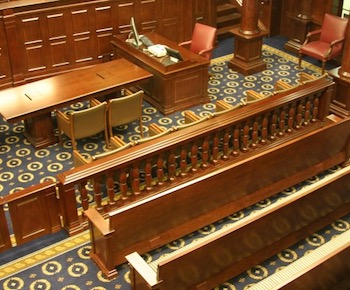LKQ En Banc Argument Suggests CAFC Could Soften Test for Design Patent Obviousness
“It seems like the court will maintain the [Rosen-Durling] step of beginning with a primary reference but will make the presence of a primary reference a general rule rather than an absolute requirement.” – Chris Carani, McAndrews
An en banc panel of the U.S. Court of Appeals for the Federal Circuit (CAFC) today heard arguments from LKQ Corporation, the U.S. government and GM Global Technology Operations in a case that could change the test for assessing design patent obviousness. The judges seemed interested in tweaking the existing “Rosen-Durling” test but struggled with getting the parties to clearly articulate a replacement approach wouldn’t be potentially just as bad.
The so-called Rosen-Durling test for design patent obviousness requires that, first, under In re Rosen (C.C.P.A., 1982), courts identify a prior art reference “the design characteristics of which are basically the same as the claimed design.” Next, under Durling v. Spectrum Furniture Co., 101 F.3d 100, 103 (Fed. Cir., 1996)), if such a reference is identified, the court must consider whether it can be modified based on other references to come up with “the same overall visual appearance as the claimed design.”
In a January, 2023, decision, the CAFC found that, “applying the tests established in Rosen and Durling, the Board found that LKQ failed to identify a sufficient primary reference, and therefore failed to prove obviousness by a preponderance of the evidence” of GM’s U.S. Patent D855,508, which covers a “vehicle front skid bar.” The court ultimately said that “[w]e, as a panel, cannot overrule Rosen or Durling without a clear directive from the Supreme Court.”
But in June 2023, the court granted a rare en banc review following a petition in which LKQ argued that the CAFC and its predecessor court have been applying a “rigid approach” to determining obviousness of design patents for 40 years, and that the Supreme Court’s 2007 holding in KSR International v. Teleflex, Inc. expressly overruled such an approach. The petition asked the en banc court to consider the following two questions:
“1. Whether the rigid approach to evaluating the obviousness of designs under In re Rosen, 673 F.2d 388, 391 (CCPA 1982) and Durling v. Spectrum Furniture Co., Inc., 101 F.3d 100 (Fed Cir. 1996) is consistent with the Supreme Court’s interpretation of 35 U.S.C. § 103 in KSR Int’l Co. v. Teleflex, Inc., 550 U.S. 398 (2007); and
2. What standard, consistent with KSR and 35 U.S.C. §171, should replace the current requirement that a patent challenger identify a primary reference that is basically the same as the claimed design as a prerequisite to evaluating obviousness and the further limitation that allows modification of the primary reference only if there is a secondary reference that is “so related” to the primary reference that the appearance of certain ornamental features in one would suggest the application of those features to the other.”
In its decision granting review, the CAFC vacated the panel opinion and asked the parties to address six questions in their briefs (paraphrased):
- Does KSR abrogate In Re Rosen and Durling?
- If it does not, should the court nonetheless modify the Rosen-Durling test in any way in view of KSR’s holding that obviousness tests should not be rigid?
- What should the new test be if so?
- Has any precedent from the CAFC already taken steps to clarify Rosen-Durling?
- Would eliminating or modifying the test create uncertainty?
- What differences are there between design and utility patents and what role should those difference play in a test for design patent obviousness?
The court also invited the views of the United States.
A number of amici weighed in on the case, with some, like the American Intellectual Property Law Association (AIPLA) and the United States, warning against creating uncertainty by wholly abrogating a time-tested framework, while others—mostly in the automotive and insurance industries—argued that the Rosen-Durling test is “overly-rigid” and has allowed original equipment manufacturers (OEMs) to “obtain and enforce design patents on insignificant part-variations year-over-year.”
CAFC Judges Push for Clear Guidance on Potential New Test
In today’s arguments, Professor Mark Lemley argued for LKQ and was quickly cut off by Chief Judge Moore, who pressed Lemley to address what the replacement test for Rosen-Durling should be. Lemley agreed with Judge Moore that there should still be an “analogous arts requirement” of some kind, but Moore seemed unclear on what the specific parameters of that would be.
“I can only find one case of ours that talks about what the standard for analogous arts is in the design patent context,” Moore said. “Nary a brief, despite the many briefs we got, educated this court on what the replacement standard for analogous arts should be.”
In its opening brief, LKQ said that KSR International Co. v. Teleflex Inc., 550 U.S. 398 (2007) rejected rigid approaches like Rosen-Durling and therefore “implicitly abrogated” the test. Instead, the test for design patent obviousness should be “the expansive and flexible approach prescribed by [Graham v. John Deere Co. of Kansas City, 383 U.S. 1, 6 (1966)] and refined by KSR, applied in the manner that approach was intended to be applied: that is, to determine whether, in light of the facts and evidence, a person having ordinary skill in the art would have found the claimed design obvious.”
Arguing for the government, USPTO Solicitor Farheena Rasheed said the court should “resist LKQ’s overreading of KSR and also resist GM’s underreading of it.” The USPTO’s middle-of-the-ground approach suggests doing exactly what the Supreme Court did in KSR, Rasheed said, which was to say the teaching-suggestion-motivation (TSM) test provides helpful insight, rather than to overrule it altogether.
But the judges did not seem clear on the government’s suggested approach either. “Our approach is to basically remove all the threshold requirements,” Rasheed said.
“What about analogous art?” asked Chief Judge Moore.
Christopher Carani of McAndrews Held & Malloy said the court’s focus on analogous art throughout the hearing was odd because the issue wasn’t before the court “and it doesn’t seem to answer the questions that were.”
Rasheed explained that the test can exist exactly as it does currently, with some changes, specifically to the second part of Rosen-Durling. “When it comes to the second part of the Rosen-Durling test we think mere similarities, as this court found in [MRC Innovations, Inc. v. Hunter Mfg., LLP]…is sufficient,” Rasheed said.
But Moore challenged this: “You want us to keep Rosen-Durling but [you say] there shouldn’t be any threshold requirements. Rosen absolutely has a threshold requirement – you can’t be considered as the primary reference unless you’re basically the same.”
Rasheed explained that the government would simply soften “basically the same” to take a more expansive approach that dictates “an overall similar visual impression.”
Finally, arguing for GM was Joseph Herriges of Fish & Richardson, who said “the Rosen-Durling framework is an important and thoughtfully-developed application of Graham tailored to the unique issues in design patent litigation. KSR did not overrule Rosen-Durling.”
Herriges said “there may be a case out there in which a patent challenger can show obviousness outside of the context of Rosen-Durling, but to my knowledge that hasn’t been an exception that’s been articulated.” He suggested if the court wants to give additional flexibility to the test, it should affirm Rosen-Durling but not foreclose the possibility that in the future, exceptions might occur, though it would likely be “a rare case, if any.”
Commenting on today’s arguments, which he attended in person, Carani said “it seems like the court will maintain the [Rosen-Durling] step of beginning with a primary reference but will make the presence of a primary reference a general rule rather than an absolute requirement.”
Getting rid of Rosen-Durling entirely would pose problems for the USPTO that Carani said the court seemed sympathetic to. “Stripping away the Rosen-Durling framework and simply leaving the process to a battle of expert affidavits submitted to the USPTO did not sit well with the court,” Carani explained.
The last time the en banc Federal Circuit took on a design patent case was in 2008 in Egyptian Goddess v. Swisa.
Matthew McKay, Senior Vice President, General Counsel & Corporate Secretary, at LKQ Corp., sent the following written statement to IPWatchdog:
“A competitive product design landscape is critical to protecting consumer choice and affordability. The rigid Rosen-Durling test of design patent obviousness is inconsistent with the dictates of the Supreme Court, and has allowed large corporations to seize monopolies for designs of products that are only trivially different than what came before. A more flexible and expansive approach is critical – among other things – to ensuring consumers have a range of safe, quality options when making basic vehicle repairs.
Judges Cunningham and Newman did not participate in today’s hearing.






